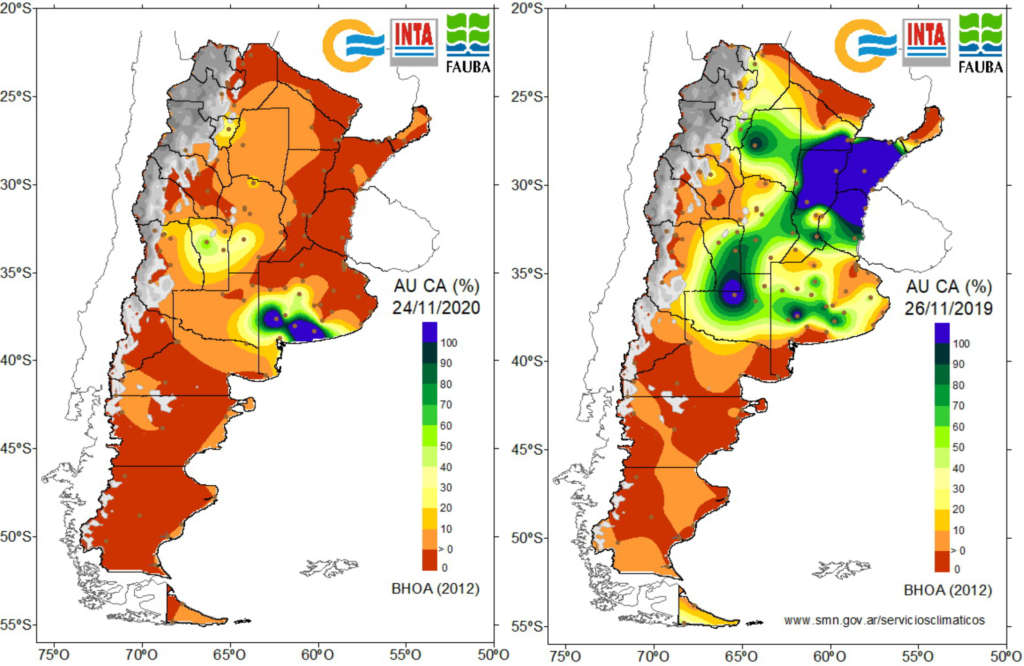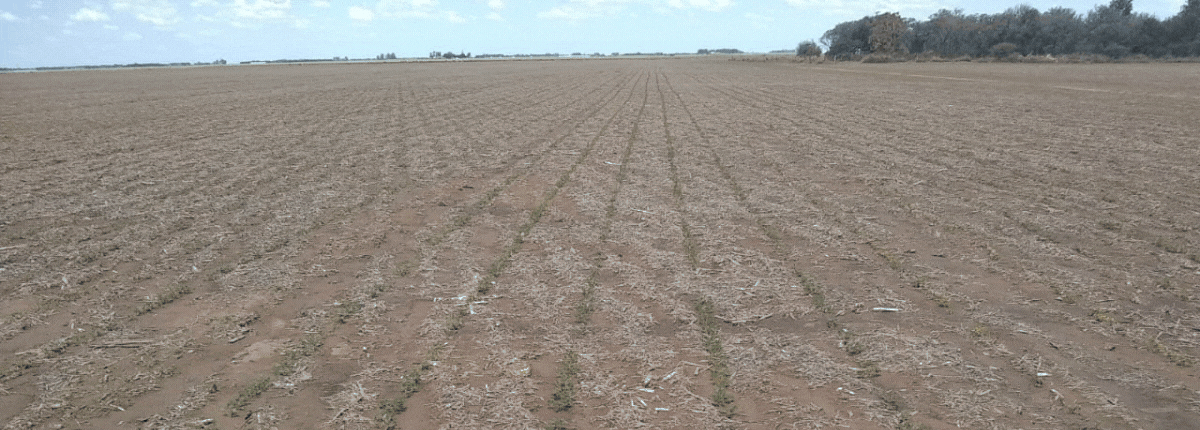Argentine Peanut Crop Report
Season 2020/2021 – #2
General Overview
Despite the lack of important and widespread rainfall in the peanut area during the winter and spring seasons, planting tasks could start without major issues after significant rains occurred during the second half of October. Rainfall was timely to increase moisture levels in the soil, allowing the beginning of a new peanut season in Argentina. As the date of this report, planting tasks are almost finished, reaching 94% of completion. In this context, the planting process will be finished before November 30th, which is considered within the optimal timeframe for planting peanuts.

Planting progress in Argentina as of November 24th
Although rains were timely and sufficient to ensure plantings, the moisture levels in the soil are far from optimal. This situation can be especially depicted in the Northern area, where rains were less significant and scattered.
Some of the most renowned extended weather models forecast a season with high predominance of La Niña phenomena, which means that rains will be insufficient during the next 3 or 4 months. Towards February, the season should turn to a more neutral condition, bringing rains that will be surely needed by the crop.
As of the date of this report, 70% of the planted peanuts are already on a germination and early emergence stage, whereas the remaining 30% are on an implantation and early emergence stage.

Emerging peanuts in the Southern area
Main Peanut Area Map
The main peanut area in Argentina includes the provinces of Cordoba, La Pampa, San Luis and Buenos Aires. In general terms, it can be divided as follows:

Main peanut area in Argentina
Rainfall and Temperature Analysis
As mentioned before, alleviating rains occurred in a big portion of the peanut region towards the end of October, mainly in the Central, South-Central and Southern areas, which are comparatively in a better situation than the Northern area.
Although scattered and of diverse magnitude, rains continued in the peanut area throughout the first half of November and brought relief to peanut producers who are monitoring the situation closely. Although we are a few months away from the maximum hydric requirements by the peanut plants, the more moisture in the soil, the better to ensure a good development.
A map of rainfall during the first half of November in the Cordoba province, which concentrates the highest amount of peanuts in Argentina, is shown below:

Accumulated rainfall in the province of Cordoba during the first half of November 2020
Regarding temperatures, records for the first half of November were normal. Minimum temperatures hovered around 15°C whereas maximum records were between 27 and 28°C. Towards the 3rd week of November, the minimum temperature records increased to 18°C, thus creating optimal conditions for the seed to emerge. Maximum temperatures also increased to records between 29 and 31°C.
Available Water Content in Cordoba
The maximum retention capacity or “field capacity” implies that the extraction of water by the vegetables occurs without any difficulty. Between the field capacity and the permanent wilting point there is the range of what we call useful water in the arable layer.
The following figure shows that, towards the end of November in the peanut area, the average values are between 10% and 20% of useful water in the arable layer (temporary drought condition). As can be seen in the graph, moisture levels deteriorated significantly in relation to the values recorded at approximately the same date of 2019. Source: FAUBA.

Available Water Content in Argentina as of November 24th, 2020 vs situation as of November 26th, 2019
Extended Weather Forecasts
According to ENSO, as it was stated in the previous report, probabilities favor a marked development of La Niña conditions, which in the Southern hemisphere means that rains are expected to be scarce, especially till the first quarter of 2021. If the forecasts are met, erratic rainfall can be expected, given that some areas could receive abundant rains whereas others might not receive rains at all. This phenomenon is typical of La Niña seasons with later preponderance of neutral conditions.

Model-Based Probabilistic ENSO Forecast by the International Research Institute for Climate and Society – Columbia University

ENSO probability forecast evolution analyzed in 3-month periods
Crop-related Tasks
With an optimal soil temperature scenario, a good germination and emergence of peanut plants is being achieved in most of the peanut areas.

Peanut plants in an early emergence state
Considering that planting tasks are almost finished, the focus is now on the herbicide treatments to control resistant weeds. This task gets harder every year because weeds develop natural resistance to the existing herbicides, forcing agronomists to find other alternatives to obtain satisfactory results. However, the main issue this year is related to the lack of considerable rainfall, given that the soils cannot incorporate the herbicide particles effectively, reducing the impact of the agrichemicals significantly.
Agronomical Challenges
This year, a special challenge related to the state of the peanut seeds was evidenced, since many peeled and split peanuts appeared prior to and after applying professional polymers treatment to the seeds. This problem was related to the seeds’ low moisture levels as a consequence of a 2020 crop that was harvested with extremely low levels of moisture. Last crop’s good news (low moisture that avoided the need to use artificial drying) became a problem for this year’s seeds. Therefore, since a large amount of seeds were peeled or split in the process, farmers from various areas had to increase planting densities (+18%) to achieve the goal of 14 healthy seeds per meter.

Peanut seeds after professional polymer treatment, showing a significant quantity of peeled and split kernes
Final Remarks
With only 6% to go, we can consider that planting tasks of the new peanut crop 2020/2021 in Argentina will be finished without major issues and within the optimal timeframe. Rains were timely and enough to ensure a good beginning and a successful completion of the first stage, but more rains will be needed in the near term in order for the peanut plants to begin their development process. According to the extended weather forecasts, rains may not show up in the horizon, at least for a few months, so it will be important to monitor the situation closely.
The planted area in October 2020 was smaller in percentage terms compared to the same month of 2019. The lack of significant rainfall was the main reason why plantings were delayed and, despite the initial concern, it was a good outcome if the extended weather forecast is considered.
With this auspicious beginning, provided weather conditions are suitable during the development cycle, Argentine peanut companies and everyone involved in this business expect another good crop that helps the peanut industry to continue the growth path started several years ago.

Peanut plants emerging in the South-Central area

Peanut plants emerging in the Eastern area
Do you have a commercial inquiry?
Other questions or comments?
Contact us: stembras@gastaldihnos.com.ar
Follow Gastaldi on social media:



